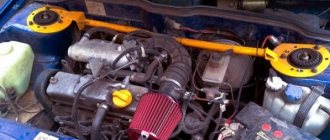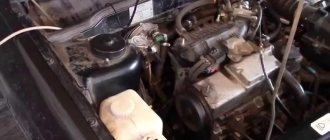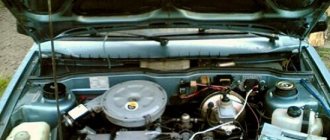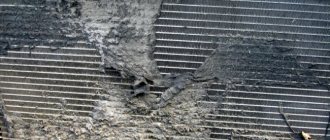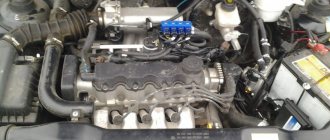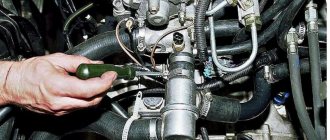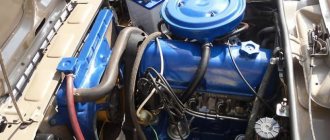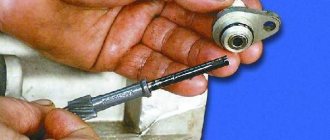Many owners of a VAZ 2109 with an injection engine have encountered a problem when the car begins to jerk and jerk, and traction is lost. This is a fairly common malfunction for all power units and injection systems. In this article we will analyze the main causes of the malfunction, as well as methods for solving the problem.
Identification of an idle cylinder
The method for identifying a bad cylinder depends on the type of engine power system.
In carburetor engines, the determination of a failed cylinder is carried out experimentally. The essence of the method is to turn off each cylinder one by one by removing the tip of the high-voltage wire from the spark plug while the unit is running.
The check should begin with the 1st cylinder on a warm engine and with the speed set at 1500 rpm. If, after removing the tip, the speed drops significantly (the engine stops altogether, since as a result 2 cylinders will be switched off), the 1st cylinder is working normally.
Next, the test is carried out on the following cylinders. If the cylinder is not running, removing the tip will not affect the operation of the motor. After turning off the “drawdown” there will be no revolutions.
This test method is simple and allows you to accurately determine which cylinder is not working. But when doing it, follow safety precautions. High-voltage wires carry electrical impulses with high voltage but low current. These impulses will not cause damage to health, but the sensations are not pleasant.
As for the VAZ-2109 engine with an injector, the experimental method should not be used here (so as not to affect the operation of electronic systems). On such engines, the determination of an inoperative cylinder is carried out by scanning the ECU for errors. Interruptions in the operation of the motor are monitored by electronic systems and recorded in the form of error codes, by deciphering which we find out what caused the disruption of the normal functioning of the unit.
Video: VAZ-2109. The engine is shaking!
Let's sum it up
If your nine stalls immediately after it starts and does not want to idle, then first of all you need to check:
- Is the ignition system working?
- Is the power system working?
First, make sure that you haven’t run out of fuel (yes, that happens). If there is gasoline in the tank, open the hood and do a visual inspection of the engine and carburetor. Make sure all the wires are in place (at least none of them are loose or burnt). The rburetor, fuel pump and gasoline hoses also need to be carefully examined. If gasoline leaks somewhere, you can’t drive any further, you can’t even start the car. It is best to use the services of a tow truck. It is also necessary to check whether the oil level in the engine meets the established standards (look at the dipstick marks) and the antifreeze level. To superficially check the adequate operation of the ignition system, you need to check the contacts. An ohmmeter is used for this. If everything is normal, the device will show zero resistance. Otherwise, you will have to replace the contact group or the entire ignition switch. The most important thing is to remain calm if the car stalls while driving. Remember to turn on your hazard lights and try to stop slowly and smoothly (or pull over to the side of the road) so as not to interfere with other road users.
Checking the ignition system
The reason that the VAZ-2109 engine “troubles” is the ignition system. Due to its incorrect operation, the combustion process of the air-fuel mixture is not observed in one of the cylinders, which leads to unstable operation of the engine, severe vibration, and a drop in power.
Interruptions in the ignition system, due to which “triple” occurs, give:
- Candles.
- High-voltage wires and their tips.
- Contacts of the distributor cover (distributor).
- Hall Sensor.
These items should be checked in the same order.
Candles are one of the most common causes of tripping. Exhausted life, incorrect clearance, “breakdown” of the housing and penetration of the impulse to ground - these faults of the spark plug lead to failure or malfunction, which affects the operation of the motor.
You can verify that a spark plug is broken by replacing it with a known good one or swapping it with a spark plug from another cylinder. Replacing the spark plug can eliminate the malfunction of the power unit.
In addition to the spark plug, you should check the condition of the contact in the tip (which is put on the contact nut of the spark plug). It is made of copper and oxidizes over time, which leads to disruption of contact between the wire and the spark plug, and causes “triple” to appear.
In search of the cause, the high-voltage wires are checked next. Over time, the braiding of these wires loses elasticity and cracks, which is why voltage pulses “break through” to the ground, not reaching the spark plug.
A simple way to check the wires is to start the engine at night and open the hood. In the dark, “breakdowns” in the form of sparks are visible. If sparks are noticeable, replace the wires.
Next, look at the distributor cap and the slider. Gradually, the contacts on the slider and in the lid wear out, and they may also oxidize, which leads to loss of contact and interruptions in the operation of the spark plug.
Due to a malfunction of the Hall sensor, there is a failure in the formation of pulses supplied to the switch. Because of this, the operation of the ignition system is disrupted, in which the pulse from the coil to the distributor is missed, and from it to the spark plug.
Air supply
Excess air or lack of it is the reason that causes engine tripping. Occurs due to the system losing its tightness. The power unit begins to suck in air, the electronics do not take this process into account, and as a result, the functioning is disrupted.
Injector nozzles
Everyone will be able to check the air system, since there is nothing complicated in the procedure.
It is clear that if the pressure does not drop, then the system is completely sealed. On the contrary, if the air comes out with a hiss, then this will not only verify the leakage, but also determine the specific location of the leak.
As for the lack of air, this is due to a dirty air filter. The latter loses its capacity. What should be done. Remove the filter and evaluate the operation of the power unit without it. If there is no difference, then the air filter is not doing its job at all and needs to be replaced.
Insufficient air may also be due to throttle problems. It is also important to clean and check it in a timely manner. It is advisable to carry out the procedure during each scheduled maintenance, simultaneously with the replacement of filters, oil, etc.
Injector temperature sensor
As mentioned above, the cause of engine tripping on the injector can be sensors. They send impulses to the electronic unit. If the signal is erroneous, then the electronics are not able to correct it. For example, if information is received that the engine is cold, but it has been running for an hour, the electronics will send an order to the injectors to inject enriched fuel assemblies. As a result, tripping and a lot of other troubles will arise, including in cold weather.
You need to check this way. First, test the information from the sensors and count the errors. Compare readings with standard values. If there are large deviations, then the cause of the tripling will be found.
Malfunctions of the CPG and timing belt
Problems in the cylinder-piston group and gas distribution mechanism are another reason for interruptions in engine operation. This malfunction occurs when:
- occurrence of rings;
- piston burnout;
- burning of the valve plates and their seats.
Malfunctions of the CPG and timing, due to which the engine “trips” appear, are determined by measuring compression in the cylinders. A cylinder that operates intermittently has a lower compression rate than the rest.
Next, we establish the reason for the drop in compression. To do this, pour 20-30 g through the spark plug hole of the cylinder. engine oil, after which we take compression measurements again.
An increased compression ratio indicates the occurrence of rings. We eliminate this problem by decarbonizing the motor.
If the repeated measurement again shows low compression, you will have to remove the cylinder head to determine the cause of the malfunction.
The reason for the “triple” of the power unit can also be a breakdown of the cylinder head gasket. Due to this malfunction, a loss of compression occurs in the cylinder due to depressurization of the combustion chamber.
Problems in the power system
The power system is another component due to which the engine can “triple”. The reason for the malfunction of the power plant due to this system is a severe depletion and over-enrichment of the air-fuel mixture - either insufficient or excessive amounts of fuel enter the cylinder. But in carburetor and injection engines, a violation of mixture formation occurs due to various malfunctions.
In a carburetor system, the fuel supply is centralized (the air-fuel mixture leaving the carburetor is independently distributed among the cylinders in the manifold). Because of this feature, the likelihood of an insufficient amount of fuel entering the cylinder is eliminated, unless rings are stuck in one of them or the valves are burned.
But incorrect carburetor adjustment causes interruptions in the operation of all cylinders at the same time (a very rich mixture floods the spark plugs, while a poor mixture will not provide a normal energy output during combustion).
On a VAZ-2109 with a carburetor, a problem often arises when “triple” occurs due to interruptions in the 3rd cylinder. This is due to air leaks in the pipe that leads to the vacuum brake booster. The fitting of this pipe is located on the manifold near the 3rd cylinder and air leakage leads to a severe leanness of the mixture entering this cylinder. When looking for the cause of the problem, be sure to check this pipe.
In the injection VAZ-2109, the power supply system is distributed, and for each cylinder a portion of fuel is supplied by a separate nozzle. In such engines, “triple” may occur due to a malfunction of one of the injectors.
As a result of a breakdown or severe clogging, the injector will overflow fuel or, conversely, supply an insufficient amount of it. Flushing or replacing the injector solves the problem with engine stalling.
Finally, we note that often the reasons that the engine is “damaged” are easily discovered during a sequential search, but their elimination depends on the characteristics of the breakdown.
Source
Brake booster failure
The vacuum brake booster (VUT) of the VAZ 2109 is not formally related to the operation of the cylinders. But failure of the VUT can lead to failure of the third cylinder. The engine will start to stall.
The vacuum booster is designed to reduce the force on the brake pedal required to effectively slow down the vehicle. To do this, VUT uses rarefied air, which it takes from the intake manifold. The intake hose fitting, equipped with a check valve, is located near the combustion chamber of the third cylinder. It is this cylinder that stops working if the amplifier fails or if the supply hose is damaged.
Due to the damage, atmospheric air is sucked in, the mixture becomes leaner, and ignition does not occur. Often, malfunctions in the operation of the brake pedal are accompanied by a significant increase in the force on the brake pedal; it becomes “dull” and does not provide proper deceleration. It happens that when you press the brake pedal, the engine stops revving and runs normally, but when you release the pedal, the third cylinder fails again. All of these are sure signs of a VUT malfunction, and they require your immediate response.
It is quite simple to make sure that the reason for the failure of the third cylinder lies in the amplifier.
If you have a spare amplifier, replacing the unit yourself is not difficult and can be done by yourself. If you go to the service, be careful: in fact, you are driving with faulty brakes.
Hello! Tell me, please, the car is a nine, it shakes wildly, especially when driving uphill, I’m zero in these matters, maybe I need to change the oil? I bought a car two years ago, I haven’t changed the oil yet, why is the engine running rough? (Basil)
Hello, Vasily. A motor can stall for many reasons, all of which are outlined below.
The term troit engine VAZ 2109 means
The term “troit engine” appeared in the era of automotive development, when vehicle power plants were equipped with four-cylinder engines. If, for one reason or another, the working cylinder stopped functioning, then three cylinders remained in operation, which during operation made a characteristic sound, as if the engine was stalling in a damped mode.
Engine compression measurement for VAZ 2109
Subsequently, despite the complication of the design of the piston group and the increase in the number of cylinders, the term “troit engine” remained in use among car enthusiasts.
How to understand that the VAZ 2109 engine is troit?
The concept of “engine tripling” was invented by motorists themselves. It is associated with the design and operation of four-cylinder internal combustion engines. If one of the four cylinders failed, the internal combustion engine still continued to operate on the three remaining cylinders. But such a failure was distinguished by a characteristic sound, which was called “engine tripping” - functioning on only three cylinders. In this case, the fuel mixture in the idle cylinder will not burn as expected, but will accumulate.
If you do not respond to such a failure in the system in time, the fuel mixture will be diluted with oil, enter the crankcase with oil and dilute it thinner and thinner. In this case, the oil will lose its lubricating functions, which will lead to rapid wear of the rings, cylinder-piston group and other important parts of the car. A little later, the engine will have to be repaired not partially, but completely.
Main reasons and their definition
When the engine in a VAZ 2109 stalls, the sound of the running engine acquires a characteristic timbre, where elements of vibration and rattling can be heard, and the engine power unit does not gain speed and operates unstable.
Breakdown of high-voltage wires of the VAZ 2109 is one of the reasons why the VAZ engine may start to fail
At the same time, the engine speed is unstable, its operation is not uniform, it makes sounds as if the engine is overcoming some invisible obstacle. The muffler emits intermittent exhaust with an uneven period of exhaust emission.
Causes of unstable engine idling
Most often, a situation arises when the engine stalls at idle speed. Moreover, it makes no difference whether this happens when it’s cold or when it’s hot. There can be many reasons for this, ranging from a simple spark plug failure to malfunctions in the piston group of the internal combustion engine. While it is very easy to replace a spark plug, wear on the cylinders in the block can lead to a major overhaul.
Most often, the engine does not operate stably at idle in the following cases:
- The valves are not adjusted (clamped);
- The timing belt is installed incorrectly (the marks do not match);
- The IAC is faulty;
- The cylinder head valves are bent or burnt out (the valves can bend during a water hammer when a large amount of water gets into the air filter housing);
- The piston burned out;
- There is a malfunction in the electronic engine control system. The sensors, the ECU itself, electrical wiring and I/O wires may be to blame here.
There are many options for why the car idles at idle, but there are still the most basic ways to determine faults.
Reasons why an unheated VAZ 2109 engine fails
It often happens that a VAZ 2109 stalls when cold, but as it warms up the engine levels out and starts working stably. There could be several reasons:
- The ECU sets the fuel mixture too rich to cold;
- The spark plug does not work, but when heated, the spark plug still “breaks through”;
- The high-voltage wires are damp or moisture has entered the ignition coil;
- Parts of the piston group are worn out.
Video: Why the engine on the VAZ 2109 is tripping
Rich mixture
The engine began to stall and stopped developing maximum power. When cold it may start and stall. In this case, the air-fuel mixture is to blame, where there is a lot of fuel and little oxygen.
It floods the spark plugs with gasoline and they refuse to work. From this you can judge the quality of the fuel mixture. If there is black soot, it is rich, if it is light, it is poor.
I wrote about this in detail in other articles, go to the channel, everything is written there, the link was above.
What to do
Look for the reason. There are several possible sources of problems:
- Mass air flow sensor
. It fails and the ECU receives incorrect readings for preparing the mixture. I wrote how to check it here. - The second lambda was covered with a “copper basin”
. There is also a separate article about it. - In the case of a carburetor, a high level in the float chamber
.
And so on. There can be many reasons for a rich mixture. If you are interested, I will write a separate article on this topic. Let me know about it in the comments.
What to do and what to pay attention to
In order to determine why the engine in a VAZ 2114 is misfiring, you must follow the recommendations of professionals. First of all, you need to determine which cylinder is out of order, for this you need to:
- open the hood with the engine running;
- remember the sound and nature of the operation of the power plant;
- remove the high-voltage wires from the spark plugs one by one, if the sound and rhythm of operation changes, then continue further, as soon as it is discovered that when the spark plug is de-energized, the nature of the sound does not change, which means the faulty cylinder has been identified.
Next, you need to unscrew the spark plug and determine its condition and performance.
It is unscrewed using a special spark plug wrench, which is recommended to be carried with you in an emergency kit. It takes up little space, but is a unique key that cannot be replaced and can come in handy at the most unexpected time. After all, even simply by replacing a heavily carbonated spark plug with a new one, you can temporarily solve the problem with starting the engine.
The next step is to determine the condition of the removed spark plug. If the electrode is intact and clean, and there is a large amount of soot on the head, then with a high degree of probability it can be determined that dust has entered the combustion chamber of the cylinder, therefore the fault must be looked for in the air supply system through the air filter.
White smoke from the exhaust
As I already said, in the cold season, on almost any car you can see white smoke from the exhaust, which is not a sign of a malfunction and does not require any action on the part of the owner. The white smoke from the exhaust will disappear as soon as it warms up.
If thick white smoke comes out of the exhaust and the temperature outside is above zero, this is a reason to think about it. Most likely, antifreeze gets into the cylinders, and there are cracks or leaking gaskets in the cylinder head itself.
Checking the engine at idle
If you notice that the VAZ-2109 engine starts to stall at idle, then you need to check the following systems:
- Fuel supply system.
- Ignition system.
- Valve system.
In the first case, if the faults are in the fuel supply system, then the first step is to flush the fuel system, and then clean the injectors using ultrasound.
The second case involves problems with the ignition system. Therefore, perform the following actions:
- change spark plugs;
- check the functionality of the ignition coil;
- update the set of high-voltage wires.
In the third case, the valves are closely dealt with, that is, they should be adjusted so that they perform their functions properly. If this cannot be done, the old valves are simply replaced with new ones.
Elimination methods
It is worth understanding that tripling on a carburetor power unit will occur not only while driving, but also at idle speed. In this case, the motor will make sounds like popping noises. But the car will twitch only while driving. So, it’s worth going directly to the analysis of the process of diagnosing and troubleshooting.
Carburetor
Unlike injection engines, a carburetor is a rather finicky thing that is sensitive to fuel and the technical condition of parts. Therefore, many motorists know that the power unit can stall precisely because of the carburetor. This version of the car was equipped with an injection element marked Solex, with which many are familiar.
To cure the shaking and jerking of the car, you will have to sort out and clean the carburetor. The cleaning process occurs manually or using a special oven that heats the cleaning liquid. But, as practice shows, most car enthusiasts who clean carbs with their own hands do the process completely manually.
Calibration data for the carburetor installed on VAZ 2108, VAZ 2109, VAZ 21099 vehicles
After the carburetor has been rebuilt, it needs to be adjusted. Adjustment is carried out using quality and quantity screws until the optimal ratio of fuel supplied to the chamber for forming the air-fuel mixture is achieved.
Fuel
If for an injection engine the poor quality of fuel is even more or less tolerable and you can drive, then for a carburetor engine it is a disaster. Bad fuel not only clogs the jets, but also quickly damages the fuel pump.
Poor quality gasoline can be identified immediately, since the engine begins to “chug”, traction disappears, and if you open the float chamber of the carburetor, the liquid called gasoline will be sticky and will not pass through the nozzles well.
To eliminate the problem, you will have to disassemble and clean the entire fuel system, including the removal of the fuel tank. After cleaning, you need to fill in, albeit expensive, but high-quality gasoline and drive 50-60 kilometers to clean the valve mechanism and piston group.
Fuel pump and filter
Another reason that the engine starts to stall is an insufficient or intermittent supply of fuel to the carburetor. In this case, the problem will lie precisely in the fuel pump or a dirty filter element.
Therefore, it is recommended to check these elements for functionality. If necessary, repair the fuel pump and replace the fuel filter.
Spark
A missing spark is a sign of a malfunction of the ignition system. Namely, spark plugs, wires or a coil could have failed. Spark plugs are checked on a special spark plug stand, but if there is none, then it is necessary to inspect the elements for damage, measure gaps and resistance. If a malfunction is detected, replace damaged parts.
During the diagnostic process, high-voltage wires are measured for resistance and also inspected for damaged insulation. If you find that one or more wires are broken, they should be replaced. The new wire should have a resistance of 5 ohms.
Air filter
The air filter has repeatedly caused the tripping effect. So, this element must be changed every 20,000 km. It is untimely replacement that leads to problems with the formation of the air-fuel mixture.
